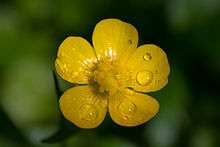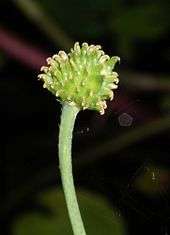Ranunculus
| Ranunculus | |
|---|---|
| Eschscholtz's buttercup (Ranunculus eschscholtzii) | |
| Scientific classification | |
| Kingdom: | Plantae |
| Clade: | Angiosperms |
| Clade: | Eudicots |
| Order: | Ranunculales |
| Family: | Ranunculaceae |
| Subfamily: | Ranunculoideae |
| Tribe: | Ranunculeae |
| Genus: | Ranunculus L. |
| Species | |
|
250–400+; see text | |
Ranunculus /ræˈnʌŋkjʊləs/[1] is a genus of about 500 species[2] of flowering plants in the family Ranunculaceae. Members of the genus include the buttercups, spearworts and water crowfoots. The petals are often highly lustrous, especially in yellow species, owing to a special coloration mechanism: the petal's upper surface is very smooth causing a mirror-like reflection.[3][4] The flash aids in attracting pollinating insects and temperature regulation of the flower's reproductive organs.[3] Buttercups usually flower in the spring, but flowers may be found throughout the summer, especially where the plants are growing as opportunistic colonizers, as in the case of garden weeds.
The water crowfoots (Ranunculus subgenus Batrachium), which grow in still or running water, are sometimes treated in a separate genus Batrachium (from Greek βάτραχος bátrakhos, "frog"). They have two different leaf types, thread-like leaves underwater and broader floating leaves. In some species, such as R. aquatilis, a third, intermediate leaf type occurs.
Ranunculus species are used as food by the larvae of some Lepidoptera species including Hebrew Character and small angle shades. Some species are popular ornamental flowers in horticulture, with many cultivars selected for large and brightly coloured flowers.
Description




Buttercups are mostly perennial, but occasionally annual or biennial, herbaceous, aquatic or terrestrial plants, often with leaves in a rosette at the base of the stem. In many perennial species runners are sent out that will develop new plants with roots and rosettes at the distanced nodes. The leaves lack stipules, have stems, are palmately veined, entire, more or less deeply incised, or compound, and leaflets or leaf segments may be very fine and linear in aquatic species. The hermaphrodite flowers are single or in a cyme, have usually five (but occasionally as few as three or as many as seven) mostly green sepals and usually five yellow, greenish or white petals that are sometimes flushed with red, purple or pink (but the petals may be absent or have a different, sometimes much higher number). At the base of each petal is usually one nectary gland that is naked or may be covered by a scale. Anthers may be few, but often many are arranged in a spiral, are yellow or sometimes white, and with yellow pollen. The sometimes few but mostly many green or yellow carpels are not fused and are also arranged in a spiral, mostly on a globe or dome-shaped receptacle. The fruits (in this case called achenes) may be smooth or hairy, winged, nobby or have hooked spines.[5]
Naming
The name Ranunculus is Late Latin for "little frog", the diminutive of rana. This probably refers to many species being found near water, like frogs.[5]
The name buttercup may derive from a false belief that the plants give butter its characteristic yellow hue (in fact it is poisonous to cows and other livestock). A popular children's game involves holding a buttercup up to the chin; a yellow reflection is supposed to indicate fondness for butter.[6]
In the interior of the Pacific Northwest of the United States, the buttercup is called "Coyote’s eyes"—ʔiceyéeyenm sílu in Nez Perce and spilyaynmí áčaš in Sahaptin. In the legend, Coyote was tossing his eyes up in the air and catching them again when Eagle snatched them. Unable to see, Coyote made eyes from the buttercup.
Splitting of the genus
Molecular investigation of the genus has revealed that Ranunculus is not monophyletic with respect to a number of other recognized genera in the family – e.g. Ceratocephala, Halerpestes, Hamadryas, Laccopetalum, Myosurus, Oxygraphis, Paroxygraphis and Trautvetteria. A proposal to split Ranunculus into several genera has thus been published in a new classification for the tribe Ranunculeae.[7] The split (and often re-recognized) genera include Arcteranthis Greene, Beckwithia Jeps., Callianthemoides Tamura, Coptidium (Prantl) Beurl. ex Rydb., Cyrtorhyncha Nutt. ex Torr. & A.Gray, Ficaria Guett., Krapfia DC., Kumlienia E. Greene and Peltocalathos Tamura. Not all taxonomists and users accept this splitting of the genus, and it can alternatively be treated in the broad sense.
Pharmacological activity
The most common uses of Ranunculus species in traditional medicines are anti-rheumatism, intermittent fever and rubefacient. The findings in some Ranunculus species of, for example, protoanemonin, anemonin, may justify the uses of these species against fever, rheumatism and rubefacient in Asian traditional medicines.[8]
Toxicity
All Ranunculus species are poisonous when eaten fresh, but their acrid taste and the blistering of the mouth caused by their poison means they are usually left uneaten. Poisoning in livestock can occur where buttercups are abundant in overgrazed fields where little other edible plant growth is left, and the animals eat them out of desperation. Symptoms of poisoning include bloody diarrhea, excessive salivation, colic, and severe blistering of the mouth, mucous membranes and gastrointestinal tract. When Ranunculus plants are handled, naturally occurring ranunculin is broken down to form protoanemonin, which is known to cause contact dermatitis in humans and care should therefore be exercised in extensive handling of the plants.[9] The toxins are degraded by drying, so hay containing dried buttercups is safe.
Fossil record
†Ranunculus gailensis and †Ranunculus tanaiticus seed fossils have been described from the Pliocene Borsoni Formation in the Rhön Mountains, central Germany.[10]
Selected species list
- Ranunculus abortivus – littleleaf buttercup
- Ranunculus acaulis – dune, sand or shore buttercup
- Ranunculus aconitifolius – aconite-leaf buttercup
- Ranunculus acraeus – a newly described species from Otago, New Zealand
- Ranunculus acris – meadow buttercup
- Ranunculus aestivalis
- Ranunculus alismifolius – plantainleaf buttercup
- Ranunculus allenii
- Ranunculus amphitrichus
- Ranunculus andersonii – Anderson's buttercup
- Ranunculus anemoneus
- Ranunculus aquatilis – common water crowfoot
- Ranunculus arvensis – corn buttercup
- Ranunculus asiaticus – Persian buttercup
- Ranunculus auricomus – Goldilocks buttercup (type species)
- Ranunculus austro-oreganus
- Ranunculus biternatus – Antarctic buttercup
- Ranunculus bonariensis – Carter's buttercup
- Ranunculus bulbosus – bulbous buttercup
- Ranunculus bullatus - autumn buttercup
- Ranunculus calandrinioides – high alpine buttercup
- Ranunculus californicus – California buttercup
- Ranunculus canus – Sacramento Valley buttercup
- Ranunculus cassubicus – Kashubian buttercup
- Ranunculus clivicola
- Ranunculus cortusifolius
- Ranunculus crassipes – subantarctic buttercup
- Ranunculus cymbalaria – marsh buttercup
- Ranunculus dissectifolius
- Ranunculus eschscholtzii – alpine buttercup
- Ranunculus flabellaris – yellow water buttercup
- Ranunculus flammula – lesser spearwort
- Ranunculus fluitans – river water crowfoot
- Ranunculus glaberrimus – sagebrush buttercup
- Ranunculus glacialis – glacier buttercup
- Ranunculus gmelinii
- Ranunculus gormanii – Gorman's buttercup
- Ranunculus hebecarpus – delicate buttercup
- Ranunculus hispidus – bristly buttercup
- Ranunculus hydrocharoides – frogbit buttercup
- Ranunculus illyricus
- Ranunculus inundatus – river buttercup
- Ranunculus jovis – Utah buttercup
- Ranunculus kadzusensis – maehwamarum,[11] Korean water crowfoot[11] (see Ganghwa Maehwamarum Habitat)
- Ranunculus lanuginosus,[12] Kabika (کبیکه) in Persian[13]
- Ranunculus lappaceus
- Ranunculus lapponicus – Lapland buttercup
- Ranunculus lingua – greater spearwort
- Ranunculus lobbii – Lobb's buttercup
- Ranunculus longirostris – water buttercup
- Ranunculus lyallii – Mount Cook lily, reputedly the largest buttercup
- Ranunculus macounii – Macoun's buttercup
- Ranunculus macranthus – large buttercup
- Ranunculus micranthus – small-flowered crowfoot
- Ranunculus moseleyi – Moseley's buttercup
- Ranunculus muricatus – spinyfruit buttercup
- Ranunculus occidentalis – western buttercup
- Ranunculus ophioglossifolius
- Ranunculus orthorhynchus – straightbeak buttercup
- Ranunculus nivalis - snow buttercup
- Ranunculus papulentus – large river buttercup
- Ranunculus paucifolius – Castle Hill buttercup
- Ranunculus parviflorus – smallflower buttercup
- Ranunculus pedatifidus – birdfoot buttercup
- Ranunculus peduncularis
- Ranunculus peltatus – pond water crowfoot
- Ranunculus pensylvanicus – Pennsylvania buttercup
- Ranunculus pinguis
- Ranunculus platanifolius – large white buttercup
- Ranunculus populago – popular buttercup
- Ranunculus pusillus – low spearwort
- Ranunculus pygmaeus – pygmy buttercup
- Ranunculus recurvatus – hooked crowfoot
- Ranunculus repens – creeping buttercup
- Ranunculus rionii – water crowfoot
- Ranunculus sardous – hairy buttercup, Sardinian buttercup
- Ranunculus sceleratus – celery-leaved buttercup
- Ranunculus septentrionalis – swamp buttercup
- Ranunculus sieboldii[14]
- Ranunculus testiculatus – bur buttercup
- Ranunculus thora – Thora buttercup
- Ranunculus trichophyllus Chaix ex Vill. – Thora buttercup
- Ranunculus trivedii
- Ranunculus uncinatus – woodland buttercup
See List of Ranunculus species for a more complete list with native ranges.
See also
References
Notes
- ↑ Sunset Western Garden Book. 1995. pp. 606–607.
- ↑ Hörandl, Elvira; Emadzade, Khatere (2012). "Evolutionary classification: A case study on the diverse plant genus Ranunculus L. (Ranunculaceae)". Perspectives in Plant Ecology, Evolution and Systematics. 14 (2): 310–324. doi:10.1016/j.ppees.2012.04.001.
- 1 2 Van der Kooi, Casper; Elzenga, Theo; Dijksterhuis, Jan; Stavenga, Doekele (2017). "Functional optics of glossy buttercup flowers". Journal of the Royal Society Interface. 14 (127): 20160933. doi:10.1098/rsif.2016.0933.
- ↑ "Buttercups focus light to heat their flowers and attract insects". New Scientist. 25 February 2017.
- 1 2 Lehnebach, C.A. (2008), Phylogenetic Affinities, Species Delimitation and Adaptive Radiation of New Zealand Ranunculus (PDF), Palmerson North, New Zealand: Massey University
- ↑ Edsall, Marian S. (1985). Roadside Plants and Flowers: A Traveler's Guide to the Midwest and Great Lakes Area: With a Few Familiar Off-Road Wildflowers. North Coast Books. University of Wisconsin Press. ISBN 0299097048.
- ↑ Emadzade, K.; Lehnebach, C.; Lockhart, P.; Hörandl, E. (2010). "A molecular phylogeny, morphology and classification of genera of Ranunculeae (Ranunculaceae)". Taxon. 59 (3): 809–828. doi:10.2307/25677670.
- ↑ Aslam, M.S.; Choudhari, B.S.; Uzair, M.; Ijaz, A.S. (2012). "The genus Ranunculus: A phytochemical and ethnopharmacological review". International Journal of Pharmacy and Pharmaceutical Sciences. 4 (5): 15–22.
- ↑ "Ranunculus". Botanical Dermatology Database. Retrieved October 18, 2013.
- ↑ Mai, Dieter Hans (2007). "The floral change in the tertiary of the Rhön mountains (Germany)". Acta Paleobotanica. 47 (1): 135–143.
- 1 2 English Names for Korean Native Plants (PDF). Pocheon: Korea National Arboretum. 2015. p. 602. ISBN 978-89-97450-98-5. Archived from the original (PDF) on 25 May 2017. Retrieved 19 December 2016 – via Korea Forest Service.
- ↑ species:Ranunculus lanuginosus
- ↑ خوبانی ربانی, مینا, مهرناز آزادی, بهزاد ذوالفقاری, and پروین دهقان. 2016. "بررسی تأثیر ضد قارچی عصاره گیاه کبیکج جهت حفاظت آثار کاغذی تاریخی". گنجبنه اسناد 26 (1): 104-123. .
- ↑ Li, H. (December 2013). "Evaluation of antiviral activity of compounds isolated from Ranunculus sieboldii and Ranunculus sceleratus". Planta Medica. 71 (12): 1128–1133. doi:10.1055/s-2005-873169. PMID 16395649.
Sources
- "GRIN Species Records of Ranunculus". Germplasm Resources Information Network (GRIN). United States Department of Agriculture, Agricultural Research Service, Beltsville Area. Retrieved 8 January 2008.
External links
| Wikiquote has quotations related to: Ranunculus |
| Wikispecies has information related to Ranunculus |
| Wikimedia Commons has media related to Ranunculus. |